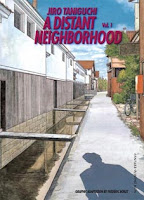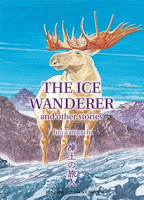My News and Reviews
I was on vacation for most of last week, which basically meant that I was camping in the backwoods of Ohio with nearly thirty of my relatives. Even with no Internet connection and no cell phone reception, I was able to schedule a few posts for while I was away. First was the announcement of the From Eroica with Love Giveaway Winner, which also includes a short wishlist of out-of-print manga. I also posted June’s Bookshelf Overload. Finally, my review for Haikasoru’s first original anthology The Future Is Japanese is up. I was really looking forward to this release and was ultimately very satisfied with it. Because I was out in the middle of the woods, I’m sure that I missed out on most of the manga news from the past week. If there’s anything particularly exciting that I should know about, please let me know! One thing that I did catch: the call for participation for July’s Manga Moveable Feast focusing on the work of Clamp.
Quick Takes
 Rurouni Kenshin, Omnibus 2 (equivalent to Volumes 4-6) by Nobuhiro Watsuki. The more I read of Rurouni Kenshin, the more I find myself enjoying the series. Watsuki does a fantastic job of incorporating historical reality into his historical fantasy. I particularly enjoy the inclusion “The Secret Life of Characters” sections which give some insight into Watsuki’s inspirations and story and character development. I’m liking the series a bit more now that Kenshin’s opponents, while still frequently over-the-top, are more realistic and slightly less bizarre. Kenshin is still easily my favorite character in the series. I was a little unsure of Rurouni Kenshin at first, but now I’m genuinely looking forward to reading more.
Rurouni Kenshin, Omnibus 2 (equivalent to Volumes 4-6) by Nobuhiro Watsuki. The more I read of Rurouni Kenshin, the more I find myself enjoying the series. Watsuki does a fantastic job of incorporating historical reality into his historical fantasy. I particularly enjoy the inclusion “The Secret Life of Characters” sections which give some insight into Watsuki’s inspirations and story and character development. I’m liking the series a bit more now that Kenshin’s opponents, while still frequently over-the-top, are more realistic and slightly less bizarre. Kenshin is still easily my favorite character in the series. I was a little unsure of Rurouni Kenshin at first, but now I’m genuinely looking forward to reading more.
 Strawberry Panic: The Complete Manga Collection written by Sakurako Kimino and illustrated by Namuchi Takumi. The Strawberry Panic manga has been discontinued in Japan, but this omnibus collects and translates everything that is available (including two chapters which were not previously available in English). The manga was my introduction to the Strawberry Panic franchise, which started out as a series of short stories. It’s a light, fluffy yuri fantasy, but I do enjoy it, even considering that the manga leaves off just as the story really starts to get going. The vaguely Catholic trappings of the all-girls schools are forgotten fairly quickly as the Etoile competition begins takes precedence in the story.
Strawberry Panic: The Complete Manga Collection written by Sakurako Kimino and illustrated by Namuchi Takumi. The Strawberry Panic manga has been discontinued in Japan, but this omnibus collects and translates everything that is available (including two chapters which were not previously available in English). The manga was my introduction to the Strawberry Panic franchise, which started out as a series of short stories. It’s a light, fluffy yuri fantasy, but I do enjoy it, even considering that the manga leaves off just as the story really starts to get going. The vaguely Catholic trappings of the all-girls schools are forgotten fairly quickly as the Etoile competition begins takes precedence in the story.
 The Summit of the Gods, Volume 3 written by Baku Yumemakura and illustrated by Jiro Taniguchi. The third volume of The Summit of the Gods serves very much as a transition. I would have liked to have seen more focus on the mountain climbing, but the volume is important to both plot and character development. It brings some resolution to Fukamachi’s obsession with Habu and provides the setup for the next major arc in the story—Habu’s astounding Everest attempt and Fukamachi’s decision to follow him. Taniguchi’s artwork is fantastic with stunning mountainscapes and detailed Nepalese cityscapes. This series is one of my favorites and I can’t wait for the next volume.
The Summit of the Gods, Volume 3 written by Baku Yumemakura and illustrated by Jiro Taniguchi. The third volume of The Summit of the Gods serves very much as a transition. I would have liked to have seen more focus on the mountain climbing, but the volume is important to both plot and character development. It brings some resolution to Fukamachi’s obsession with Habu and provides the setup for the next major arc in the story—Habu’s astounding Everest attempt and Fukamachi’s decision to follow him. Taniguchi’s artwork is fantastic with stunning mountainscapes and detailed Nepalese cityscapes. This series is one of my favorites and I can’t wait for the next volume.
 Basilisk directed by Fumitomo Kizaki. The Basilisk anime is an adaptation of the Basilisk manga which in turn is an adaptation of Fūtaro Yamada’s novel The Kouga Ninja Scrolls. The original novel is still my favorite version of the story by far. The anime does expand on some of the characters’ backstories in ways not found in either the manga or the novel, including giving an explicit reason behind the Kouga and Iga clans’ continued feuding. There are also some nice moments between Oboro and Gennosuke. Otherwise, the anime follows the manga very closely. However, the animation isn’t nearly as striking as Masaki Segawa’s artwork in the manga, which isn’t especially surprising but is still too bad. Oboro’s eyes in particular annoyed me.
Basilisk directed by Fumitomo Kizaki. The Basilisk anime is an adaptation of the Basilisk manga which in turn is an adaptation of Fūtaro Yamada’s novel The Kouga Ninja Scrolls. The original novel is still my favorite version of the story by far. The anime does expand on some of the characters’ backstories in ways not found in either the manga or the novel, including giving an explicit reason behind the Kouga and Iga clans’ continued feuding. There are also some nice moments between Oboro and Gennosuke. Otherwise, the anime follows the manga very closely. However, the animation isn’t nearly as striking as Masaki Segawa’s artwork in the manga, which isn’t especially surprising but is still too bad. Oboro’s eyes in particular annoyed me.










